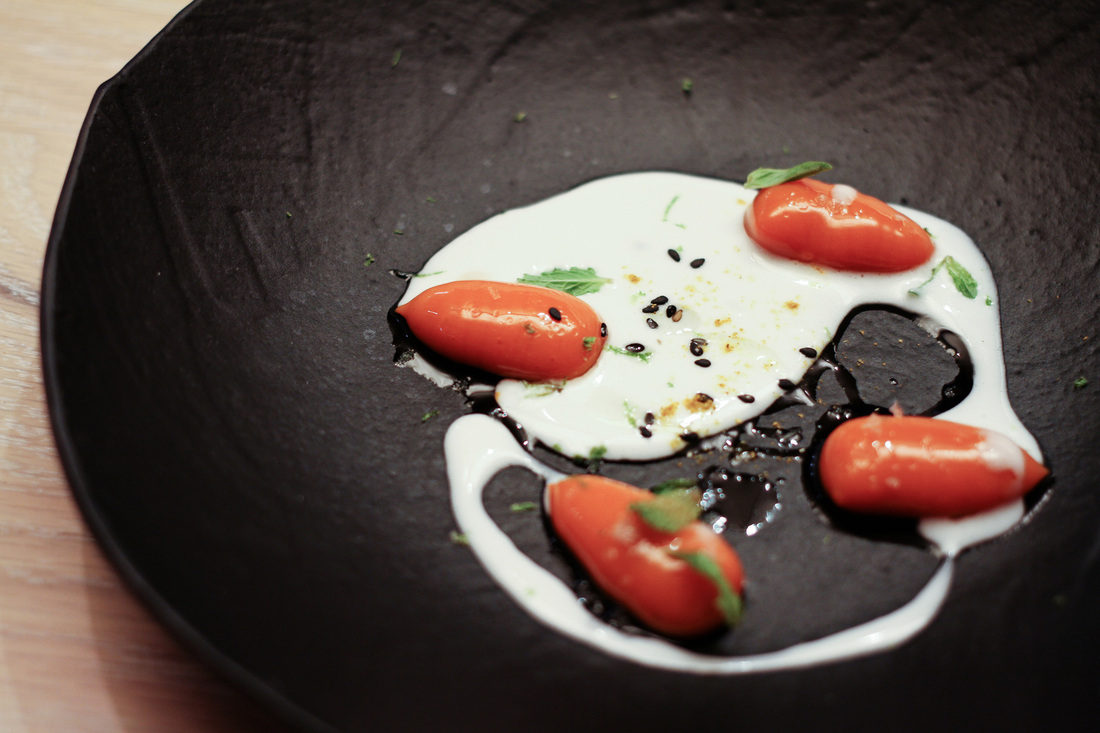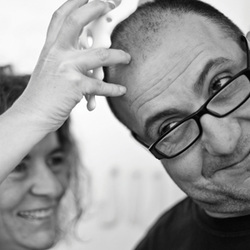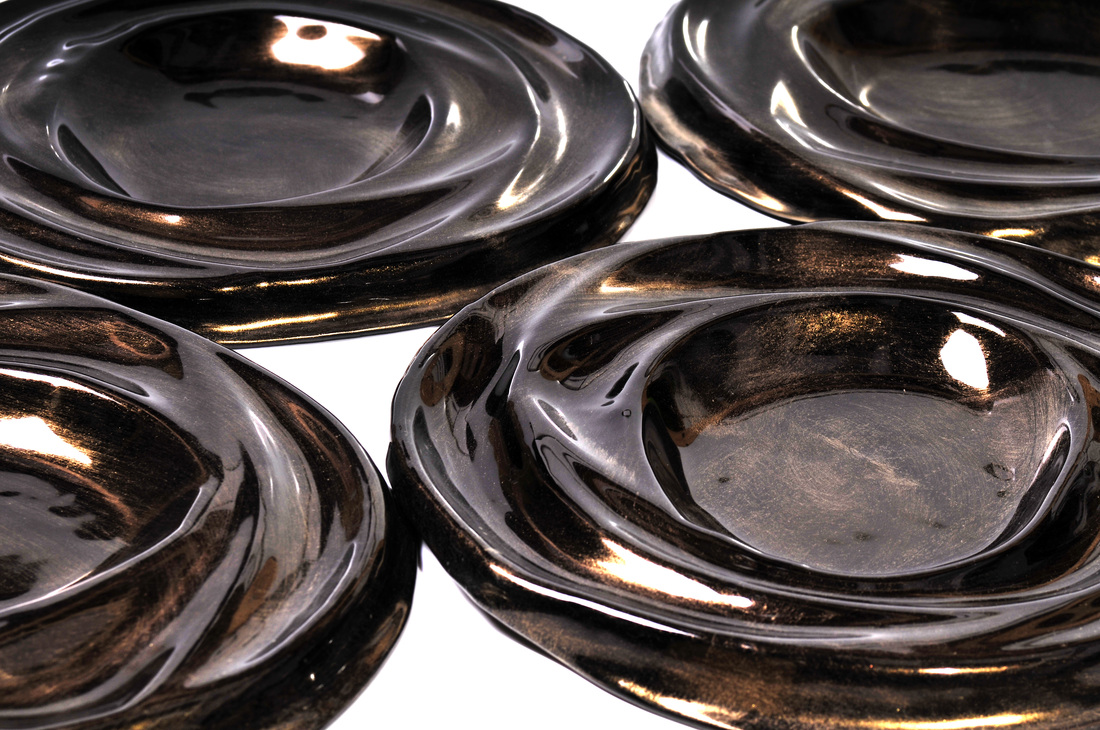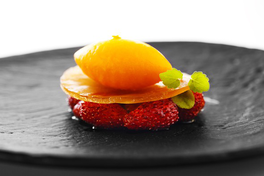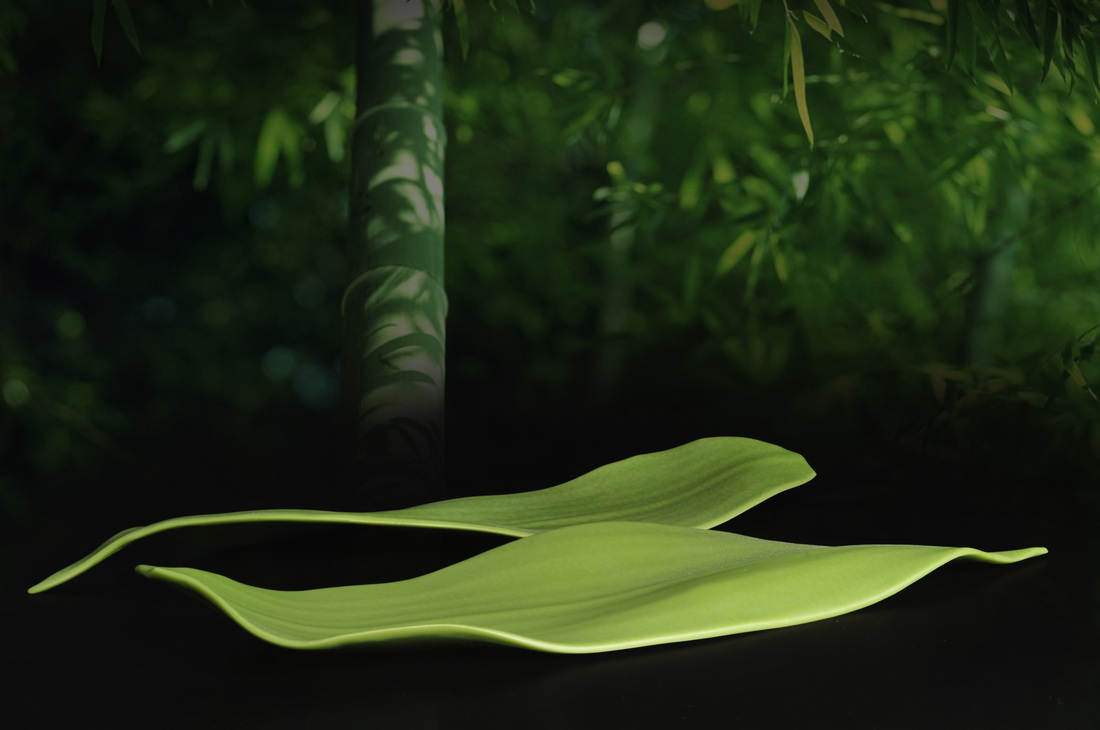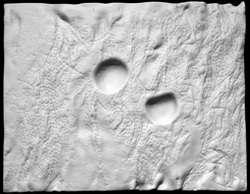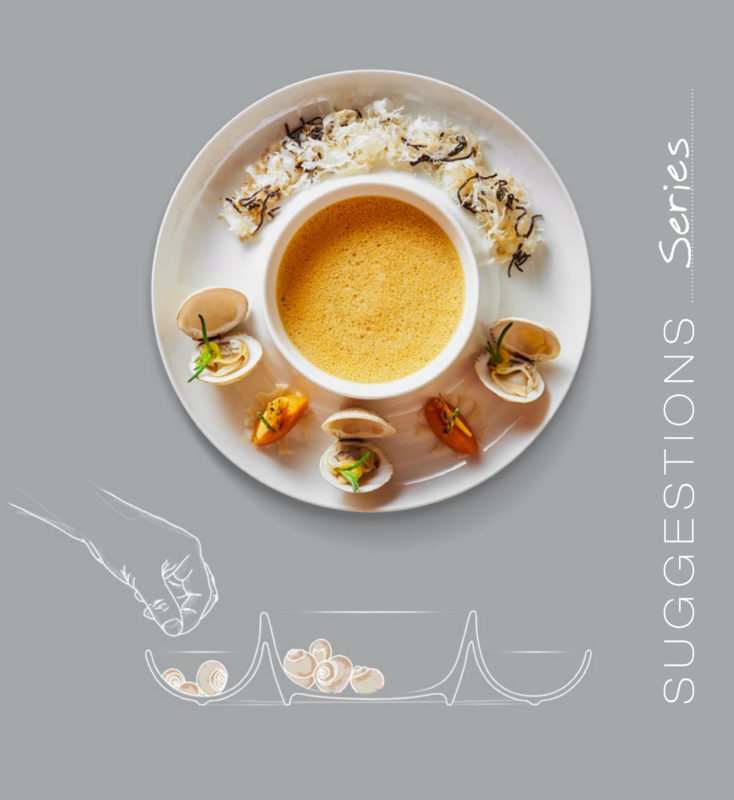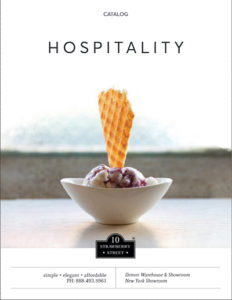A custom serving piece from Luesma & Vega’s MUNA series made for Jose Andres MINIBAR in Washington. Esther Luesma and Xavier Vega Luesma & Vega is a glass studio founded byEsther Luesma and Xavier Vega at the Poble Espanyol district of Barcelona in 2000.Luesma & Vega is all about the design and production of art objects using modern techniques of glass, designed to elevate and expand the hospitality culinary experience.
Since 2003, Luesma & Vega has been collaborating with well-known chefs around the world in the design and edition of exclusive dinnerware and serving pieces. Needless to say, creativity and innovation, while paying respect to the food, is central to the design DNA at Luesma & Vega.
Recently, we were able to get busy owner Xavier Vega to sit for a short Q&A about how this innovative tabletop source came to be and where it might be headed in the future:
TTJ: How did you decide to focus on the world of gastronomy for the artistry of your products?
L&V: Luesma & Vega is a workshop that specializes in the artistic design, creation and production of glass objects. We have been involved in a wide variety of architectural and other kinds of projects. Tableware was something that we had always found very attractive, but the opportunity to work in this area had never arisen.
Then, in 2003 we were visited by Luki Huber, the industrial designer who was creating the tableware and new tools for Ferran Adrià’s El Bullirestaurant. He wanted to consult us about the possibility of producing some pieces. They were to be made of corrugated glass at a reasonable price. We were successful in making the first piece for El Bulli.
As a result of the great success of our glass piece, when the restaurant season ended Ferran Adrià invited us to form part of a design team to create a tableware set for the restaurant. This team included Luki Huber, who came up with the concepts, Albert Raurich, the restaurant’s chef, who gave advice on formal and service requirements, ourselves, who suggested possible shapes and finishes and, finally Ferran Adrià himself, who oversaw the whole project.
This was the germ, our education in designing for haute cuisine.
In 2008 we worked directly with El Bulli’s kitchen, as the members of the team had begun other projects. This allowed us to develop items working directly with the kitchen staff, which we did until the restaurant closed.
In 2010 we decided to market some of the pieces that we had created during those years. The briefing for haute cuisine is complex. You need exclusive pieces with unique shapes that can be produced in small numbers at a reasonable price.
Fleje Series for GAGGAN in Bangkok Working within these conditions, Luesma & Vega developed what we call open processes that allow us to create personalized pieces in a variety of sizes, colors and textures at little initial cost. This experience was and continues to be very rewarding. A number of well-known chefs were happy to work together with us to develop new pieces and our catalogue grew with the addition of new models and technical possibilities.
TTJ: Where do you get the inspiration for the designs that you create?
L&V: Inspiration can come from anywhere; a stain, nature, a child’s drawing, delicious food. The design process usually begins when a chef asks us for a specific piece or suggests the concept for a dish and gives us freedom to come up with ideas. Sometimes these come quickly, while at other times progress is slower. Design is a process. One important factor is having a good understanding of the concept of cuisine and the chef’s own gastronomic inclinations. In other words, there must be a certain level of empathy.
For complex projects we have to experience the tasting menu. That way we can appreciate the chef’s individual touch, how the heart of the restaurant beats and other aspects needed to develop our designs. You could say that in addition to the practical requirements of the piece, it is important to understand the way in which the restaurant communicates in order to broaden and enhance its customer’s gastronomic experience.
TTJ: We see from you website that all your products are made from glass. How do you make them safe (at least as safe as possible) for the restaurant business?
L&V: Glass is very strong and as safe as any ceramic material. The shape of a plate and its edges can considerably increase its strength. For example, imagine a glass marble falling to the floor; it bounces rather than breaks. Obviously, a piece made of very thin glass will need to be treated with care. But this delicateness is also transmitted. Nobody would say that a wine glass is dangerous or unsafe.
Glass is a completely hygienic material and it doesn’t alter the flavor of the food. It has been used for thousands of years and is completely recyclable. Some of our pieces look like ceramics, but this is because glass doesn’t always have to be transparent. It can be opaque, white, black or a multitude of colors, both translucent and opaque.
The majority of the Luesma & Vega pieces are made with lead-free sodium-calcium glass, using a high percentage of recycled glass in optimized production processes. We work with very high quality glass and meet all the necessary safety requirements.
Some pieces are made with borosilicate glass. This is a transparent glass that is also resistant to direct flame and sharp changes in temperature.
MUNA for Albert Adria’s 41ºEXPERIENCE in Barcelona TTJ: What role do you see for your company’s products in the overall guest dining experience?
L&V: Our business was born and developed with nouvelle cuisine because of the innovations that it required. In a tasting menu that includes 30 dishes, a normal tableware item like the typical white 12-inch plate will not be suitable. It is very big and creates difficulties for the serving of certain dishes, such as food that is presented in the form of a ball.
Tasting menus and tapas involve small portions of one, two or, at the most, three mouthfuls. Tasting menus are presented in this way because the initial emotion and surprise created by a dish evaporate after the third bite. Conscious perception and attention diminish in intensity the more food you have on your plate.
This is how new kinds of food are born. Some already existed, like croquets, but now they can be organized and analyzed in order to generate new ideas. In terms of shapes, there are bite-sized pieces like tartlets (flat surface), drums, cylinders, cornets, balls, sachets and foods in the form of vapor and foam that need new kinds of plates. And as we have already mentioned, the tableware forms part of the mise-en scène of the dining experience. It must help to enhance the emotion. Chefs are well aware of the added value that tableware can bring.
Although our own experience at Luesma & Vega has been gained developing tableware for this type of cuisine, there are many pieces that can be used on a daily basis in any home. We also produce pieces designed for normal use in standard sizes. The difference is that we make an effort to ensure that they are also beautiful, based on the idea that day-to-day use and functionality are not incompatible with beauty. BAMBOO LEAF for Albert Adria’s PAKTA in Barcelona CANVAS plate for David Muñoz’ DIVERXO TTJ: Are you ever afraid of others copying your products?
L&V: It’s already happened. Some of our specific models have already been copied, along with some of our ideas. The world of industrial tableware is highly competitive and desperate for new ideas. We look on it as an honor. It means that the piece they have copied is good. What hurts is when someone copies a piece and is more successful at selling it. Fortunately we have developed a lot of processes that cannot be easily reproduced industrially. Making an exclusive 50-piece set for a reasonable price is a niche market that an industrial producer will not consider.
TTJ: What is the most influential piece or product that you have designed and produced?
L&V: We are very proud of our Muna series. It emerged after our gastronomic experience at El Bulli, which had helped us to understand tableware requirements for haute cuisine. The name ‘muna’ comes from a combination of the English word ‘moon’ and a Finnish word meaning ‘egg’. Essentially it is a shell that has the texture of the moon.
Textured pieces stimulate emotion. You touch them and they tickle your fingers. These are very thin, delicate pieces with a texture that feels like stone. The series was also very important for us because it represented a change of concept in terms of production techniques. The first piece was the one in which the innovation occurred; it marked a different way of looking at things, of understanding what was happening. Literally a complete change.
TTJ: Have you ever produced cups and saucers or other drinking vessels for beverages? Or, has it always been just serving pieces for food items?
L&V: We have also produced pieces for liquids, small bowls for dashi and glasses for sake. The technique we use limits us to a certain extent and we cannot compete with industrial developments in blown glass, which can do wonders. However, if a chef needs a special and unique glass, we can come up with some ideas.
TTJ: What new pieces are you working on at the moment?
L&V: At present we are developing special pieces for a number of restaurants. The majority close during the winter, and it is during this period that we design new models in partnership with their chefs. We are currently working on a collection for the Mugaritz restaurant (I can’t say anything more at the moment), for Koy Shunka (we have been regularly designing new models for them for the last three years), and for Carme Ruscalleda, who we are very happy to be working with for the first time. One curious project that we are working on is a plate to serve 12 oysters for Simon Gault’s Eurobar restaurant in New Zealand.
TTJ: Where can creative chefs around the world find out about your products and buy them?
L&V: You can find all the necessary information on our website at www.luesmavega.com.
We have distributors in the USA and Central Europe for our standard series. If you visit Barcelona, Spain, you can come to our workshop and visit our showroom.
TTJ: What is the best selling….or at least the favorite…piece from Luesma Vega?
L&V: In 2013 we completed some really exciting projects. We made 4 very special pieces for “El Somni” at the Celler Can Roca, some of them sculptural in shape. This was a very interesting and highly complex multidisciplinary project. We learned a lot. At the Diverxo restaurant we developed a David Muñoz concept that we believe helped him win his third Michelin star. The concept is very exciting. For David, plates are transformed into canvases, with textile-like surfaces. We developed an entire catalogue of different material textures in glass; smooth, creased, paper-like, etc. The food is actually put on the plate in the dining room by the chefs, so the gastronomic experience is enhanced by an element of performance and show cooking.
We are also proud to be continuing our work with the Adrià brothers on their current projects, like 41º Experience, Tickets, Pakta and Bodega 1900. We are particularly pleased with a plate that we have made for Pakta, which looks like a bamboo leaf.
To learn more about Luesma & Vega and their seemingly never-ending tabletop creativity, go here: http://luesmavega.com/

